Morocco - Overseas Adventure Travel tour
April 5-25, 2022
Part Two - Main trip on Morocco tour
Page Six - Volubilis and the Sahara Desert

Seen on the way from Fez to Volubilis, an ancient
Roman city. Handmade hot pads and other items
were being sold
by a vendor along the roadside.
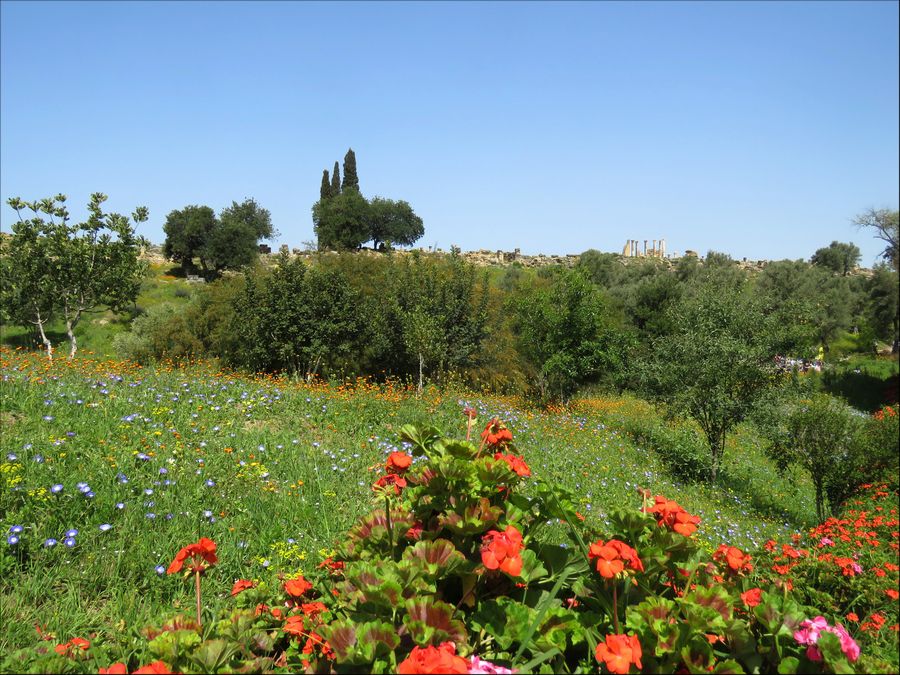
Volubilis is a partly excavated Berber-Roman city
near the city of Meknes. Built in a fertile agricultural area,
it developed
from the 3rd century BC as a Berber, then Carthaginian,
settlement
before being the capital of the kingdom of Mauretania.
It grew rapidly
under Roman rule from the 1st century AD onward.
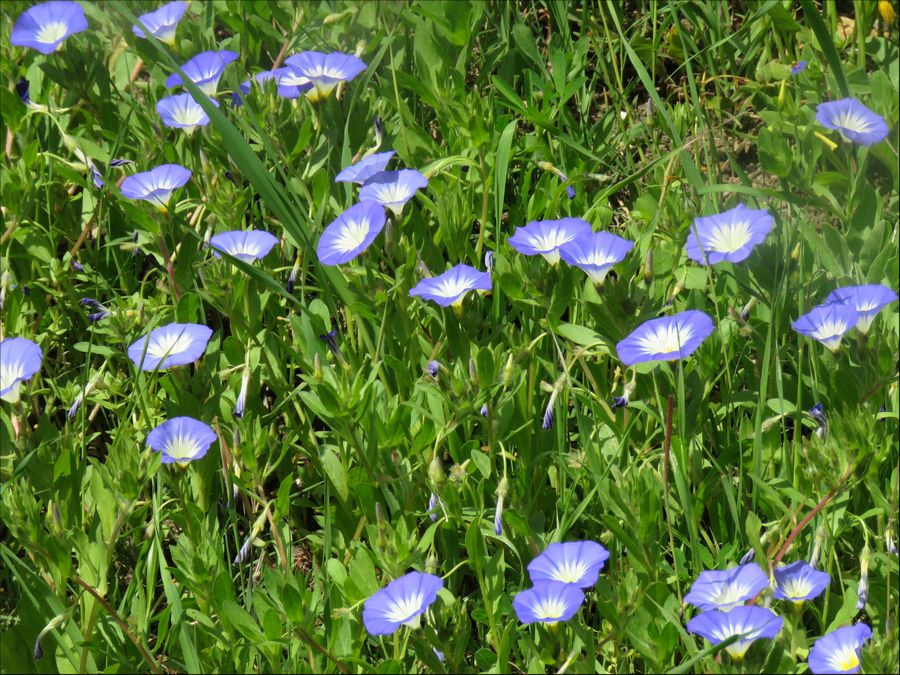
The area around Volubilis was full of wildflowers.
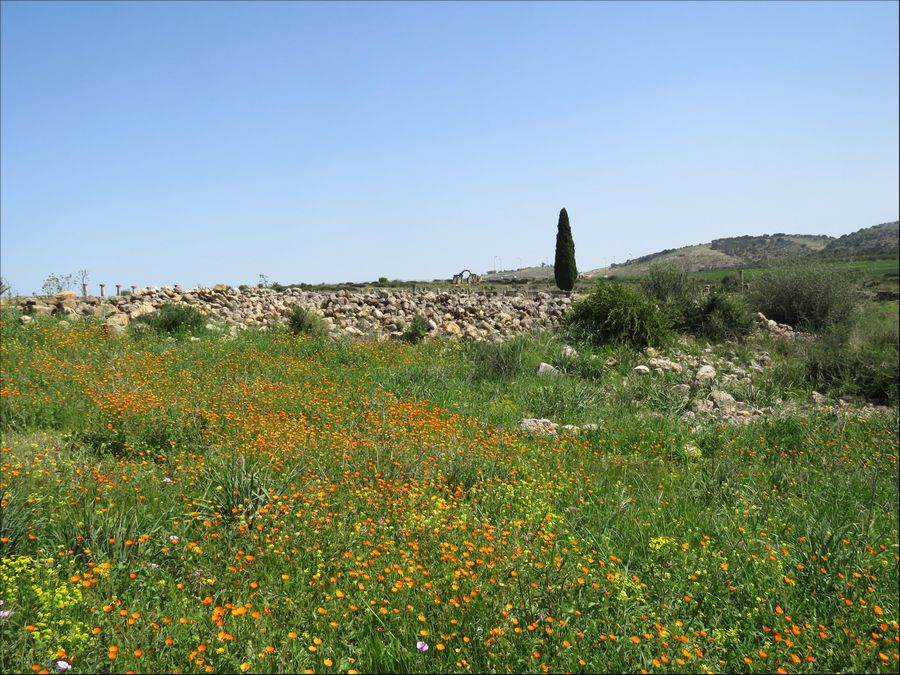
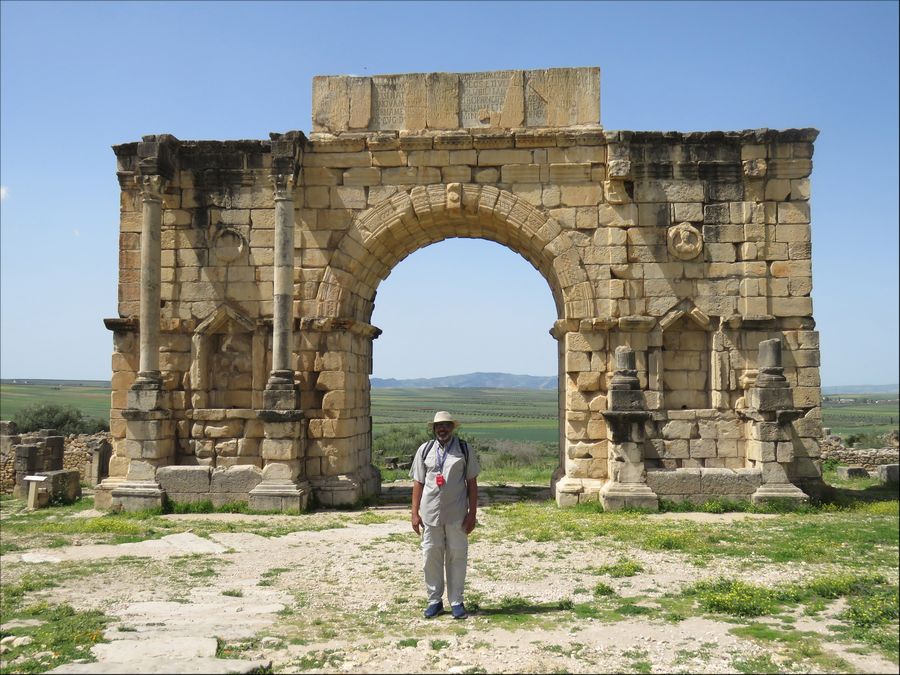
Arch of Caracalla (Triumphal Arch)
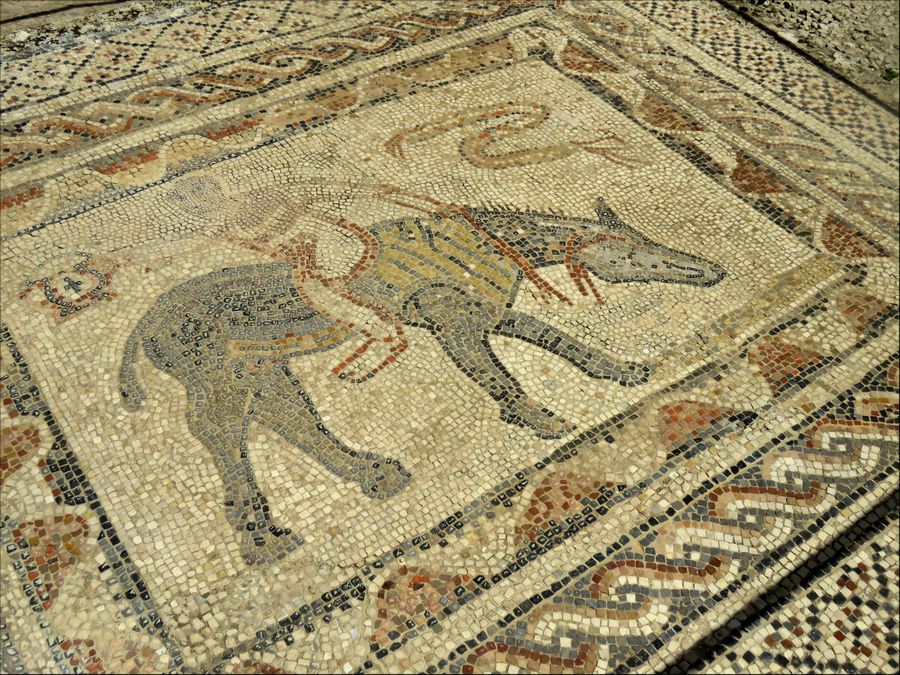
Well preserved mosaic, showing a rider facing backward
on a horse.
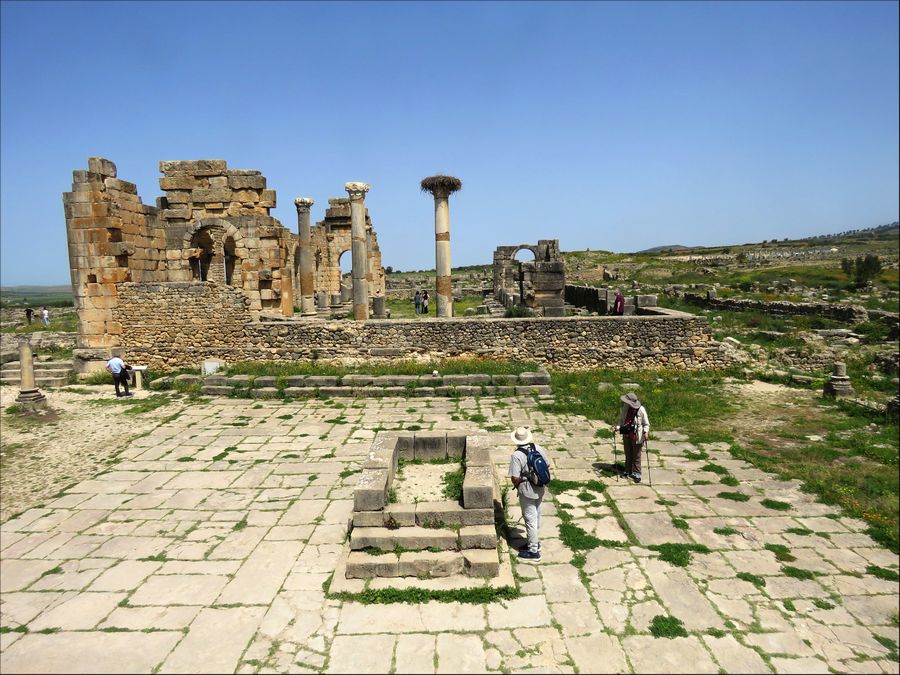
The ruins remained substantially intact until they were devastated by
an earthquake in the mid-18th century and subsequently looted by
Moroccan rulers seeking stone for building Meknes. It was not until
the latter part of the 19th century that the site was definitively identified
as that of the ancient city of Volubilis. During and after the period of
French rule over Morocco, about half of the site was excavated, revealing
many fine mosaics. Some of the more prominent public buildings
and high-status houses were restored or reconstructed. Today it is a
UNESCO World Heritage Site, listed for being "an exceptionally well
preserved example of a large Roman colonial town on the fringes
of the Empire."
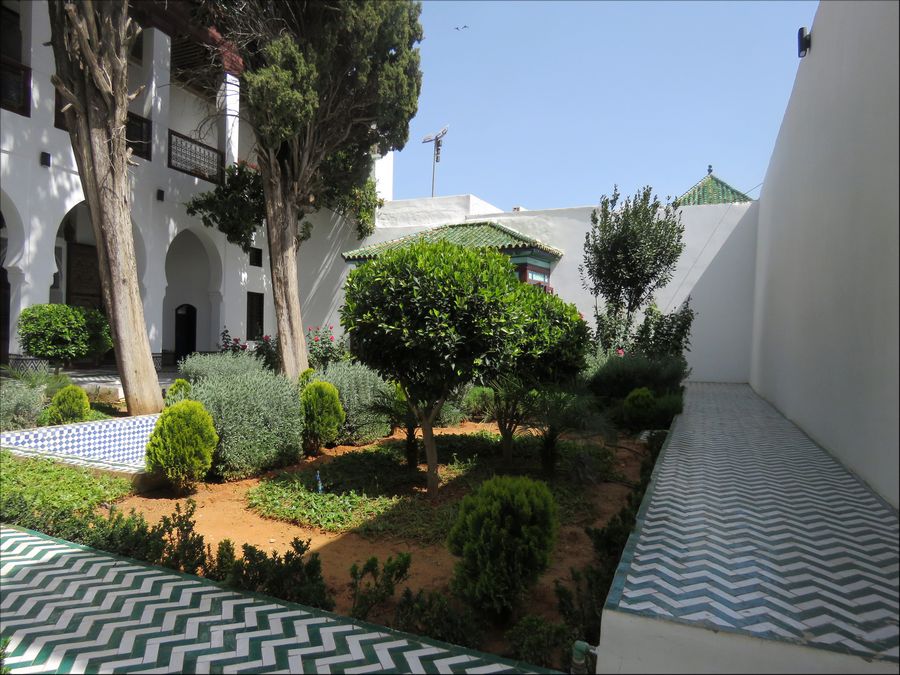
Courtyard of a Moroccan music museum we visited in Meknes,
Dar Jamai Museum, the National Museum of Music.
It was a residence built in 1882. Meknes is one of the 4
Imperial Cities of Morocco (the 4 historical capital cities):
Fez, Marrakesh, Meknes, and the current capital Rabat

We traveled from Fez to Erfoud the next day, about 300 miles through the
Middle Atlas Mountains. In one area in the mountains, we saw
Barbary macaques.They obviously were there because
vendors and others frequently feed them. We did not.
The Barbary macaque is native to the Atlas Mountains of Algeria
and Morocco.
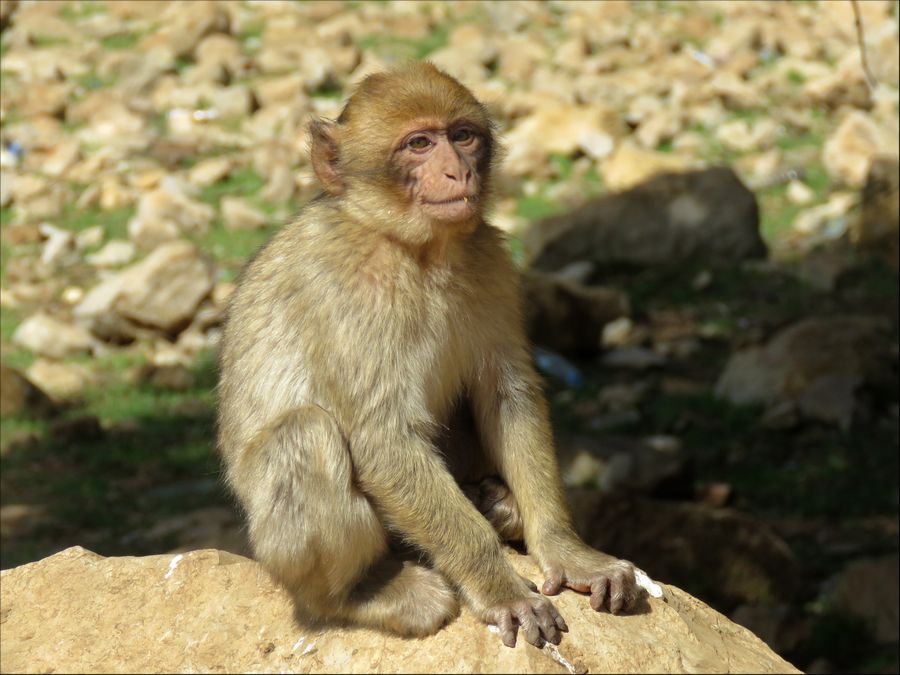
Males play an
atypical role in rearing young.
Because of uncertain paternity, males
are integral to raising all infants. Generally, Barbary macaques of all
ages and sexes contribute in parental care of young.
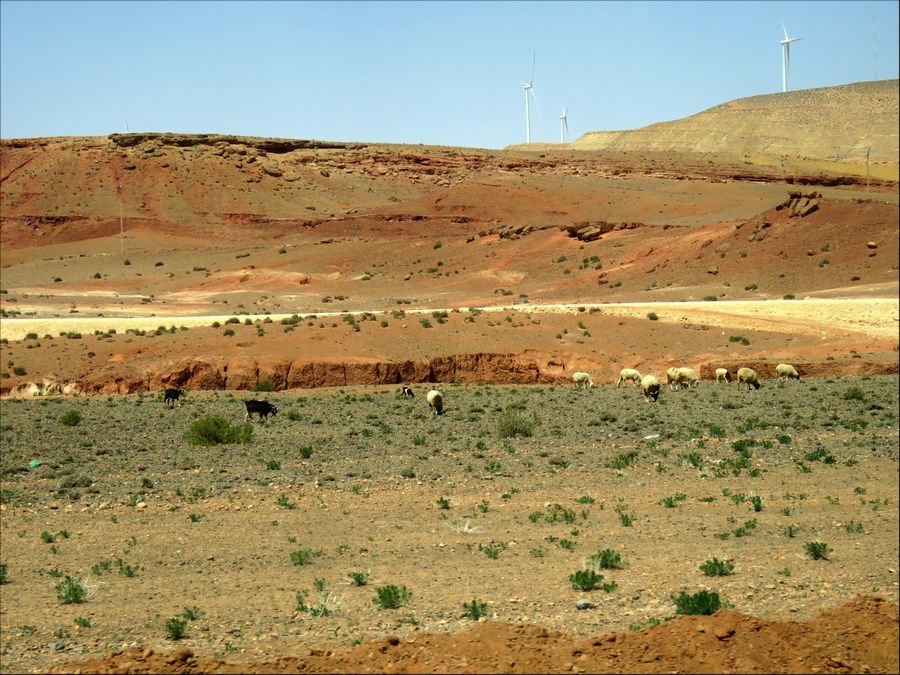
As we drove to Erfoud, which is on the edge of the Sahara Desert,
the terrain became more arid. Note the windmills in the background.
In 2009, Morocco set out an energy plan which aimed for 42%
of total installed power capacity to be renewable energy by 2020.
Morocco later pledged to increase the renewables in its electricity
mix to 52% by 2030, made up of 20% solar, 20% wind and 12% hydro.
In terms of wind power development, Morocco has quite favorable
wind resource patterns, both in the northern part of the country near
Tangier and to the west where certain regions benefit from regular trade winds.
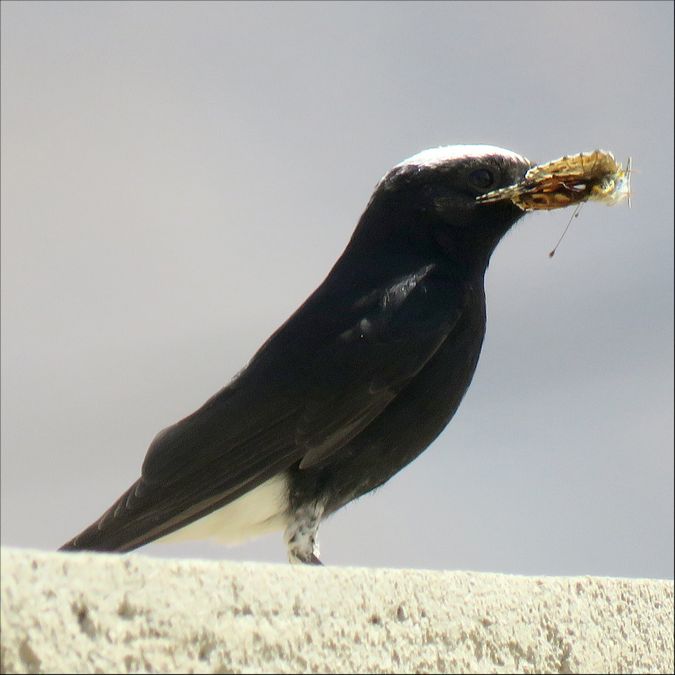
White-crowned wheatear
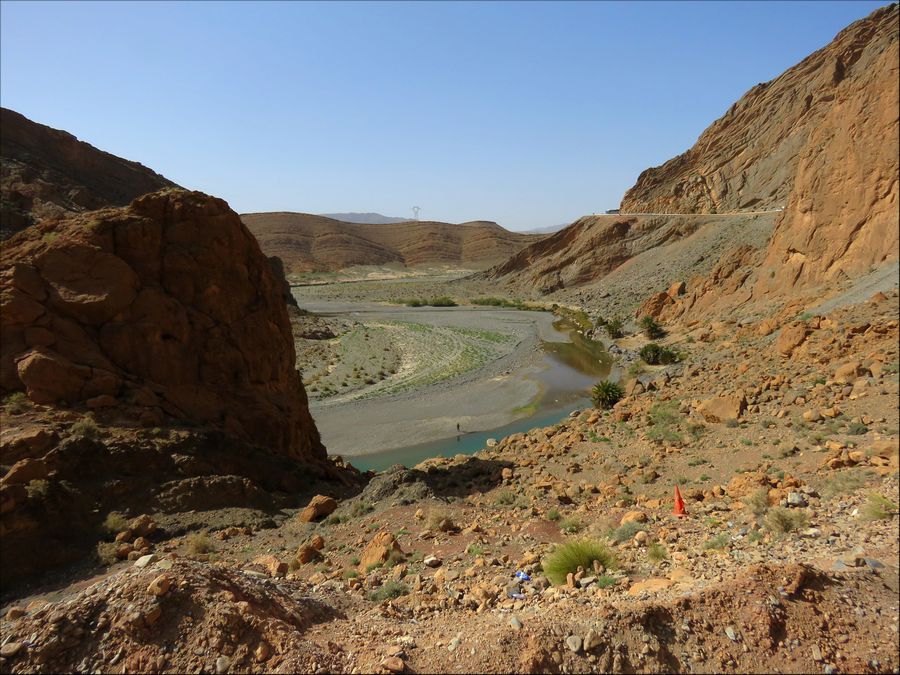
Views along the road to Erfoud
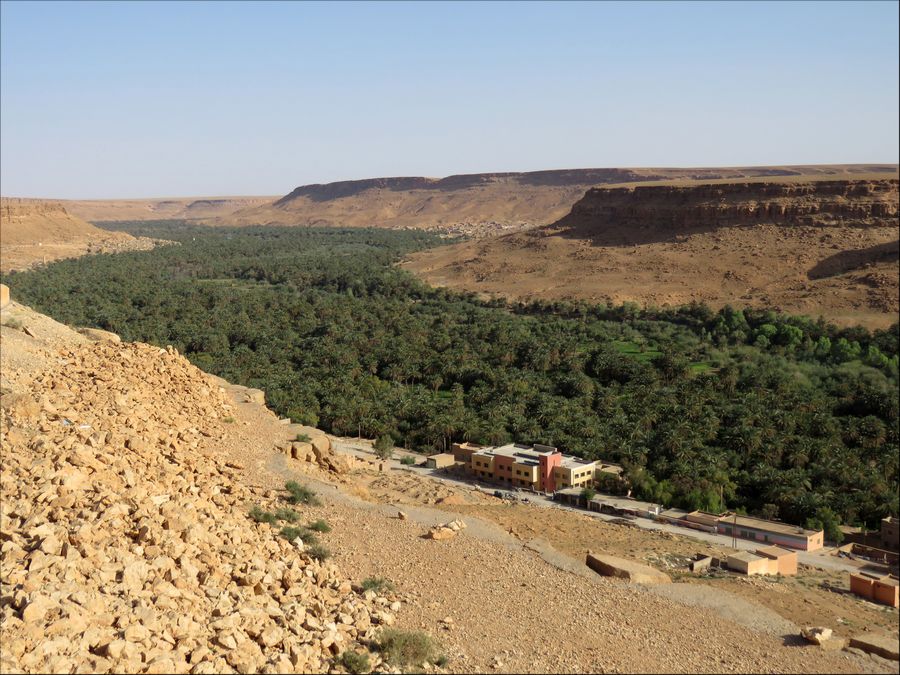
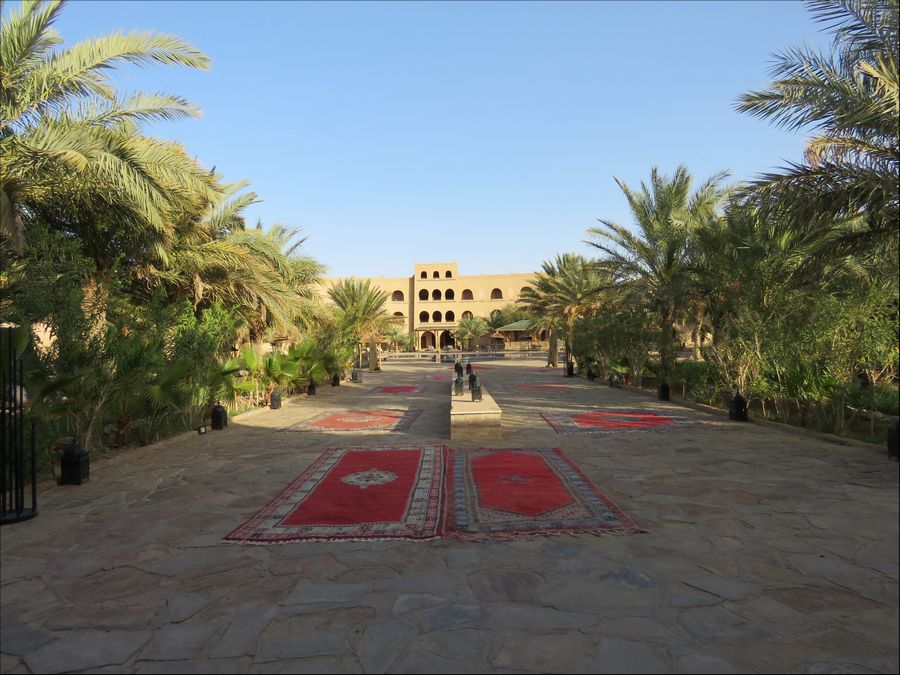
Courtyard of large hotel where we stayed in Erfoud
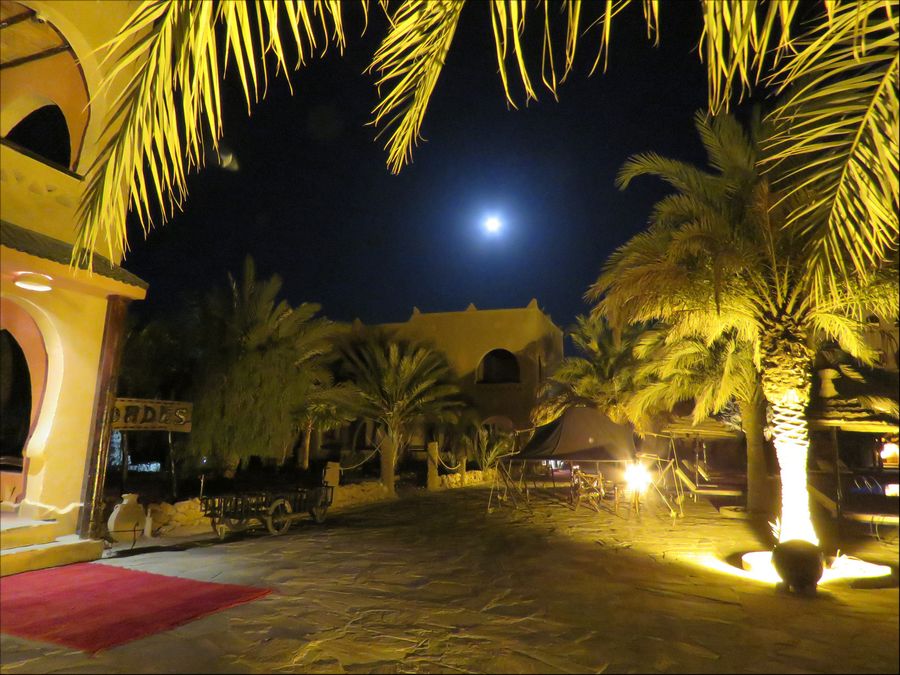
Nighttime at the hotel
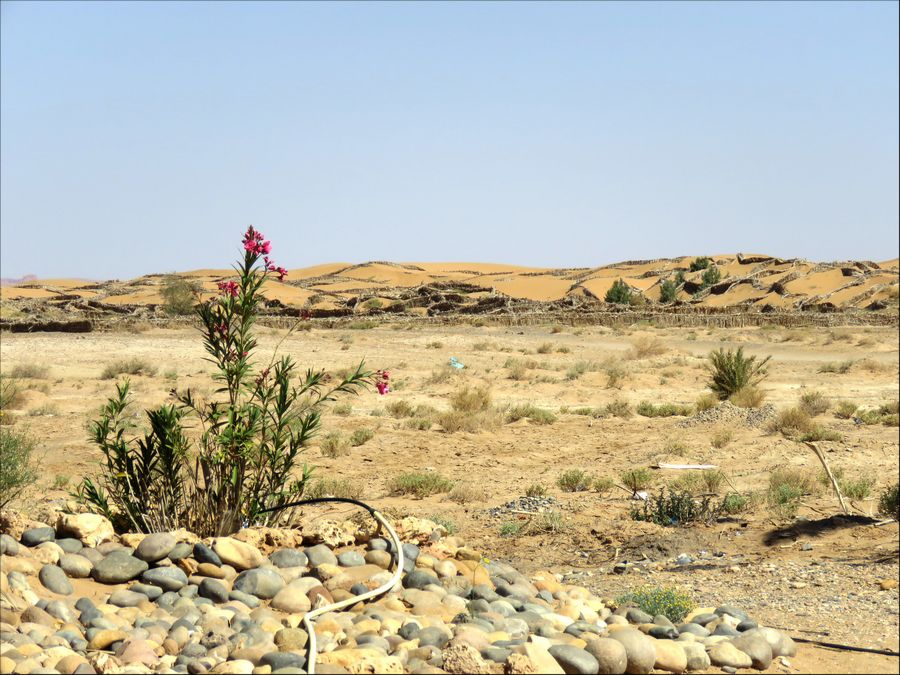
A view from the Erfoud hotel the following morning.
The fences in the background help contain sand blowing
during sandstorms. Erfoud is a small trading village on
the edge of the Sahara Desert.
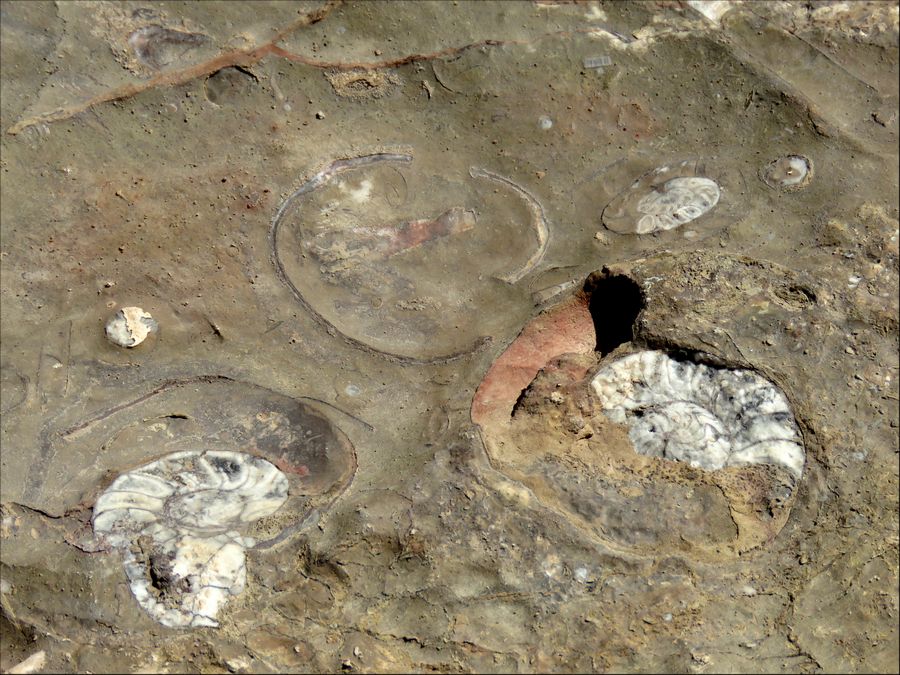
There were many fossil stores in the Erfoud area. We stopped at one.
Morocco contains some of the world's richest fossil sites,
with international interest from fossil collectors since the early 20th century.
As interest in collecting fossils grew in the late 20th century,
the Moroccan fossil trade grew into a lucrative industry of its own.
More than 50,000 Moroccans earn their living in mining, trading
or exporting fossils and the industry itself is worth more than $40 million annually.
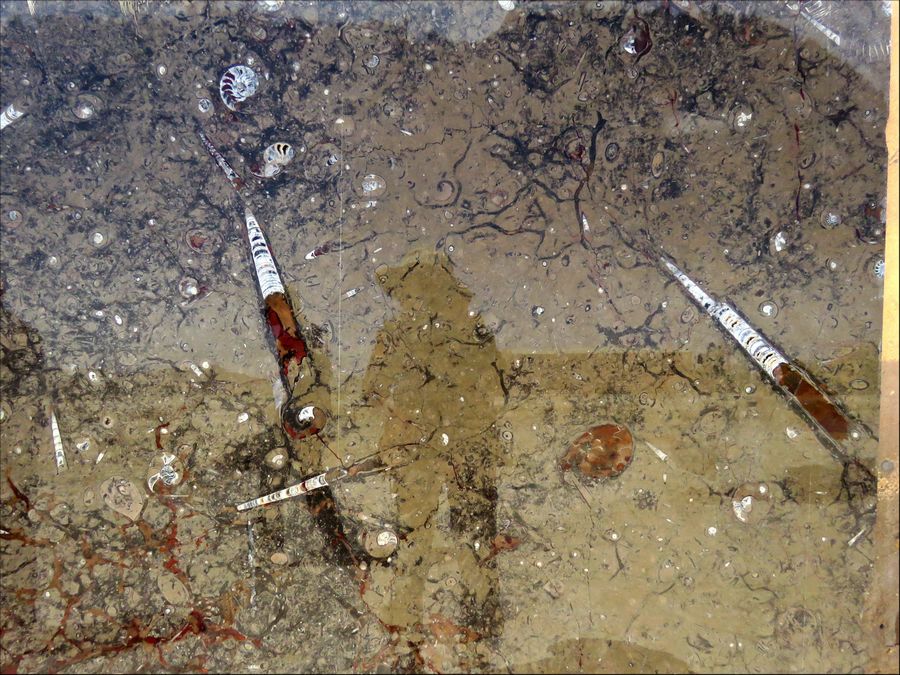
Later, when we were in the desert, we walked in an area containing
many rocks with fossils. The store we visited had many for sale, and
products made with fossils in them.
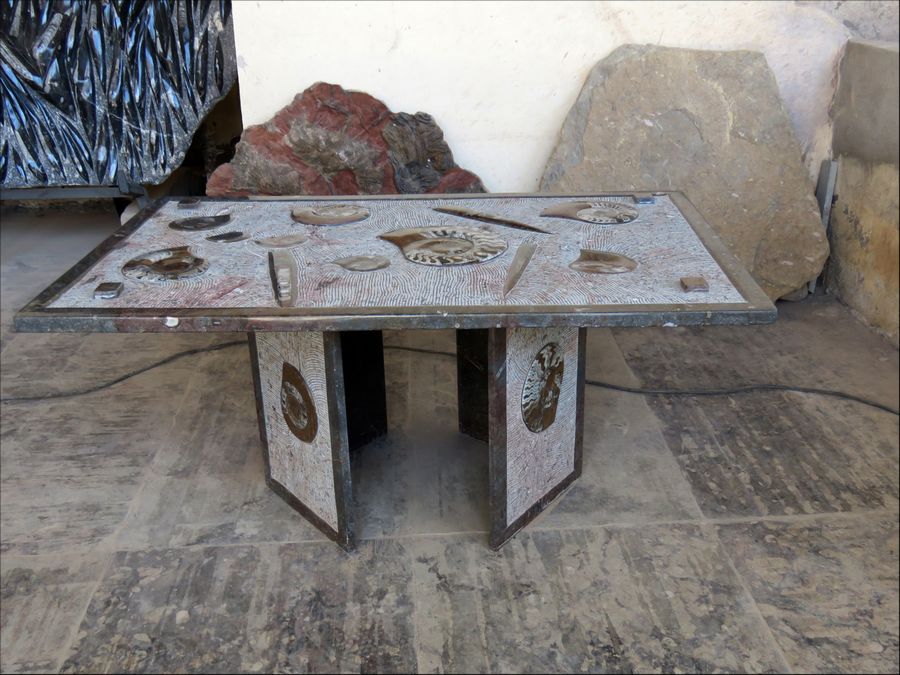
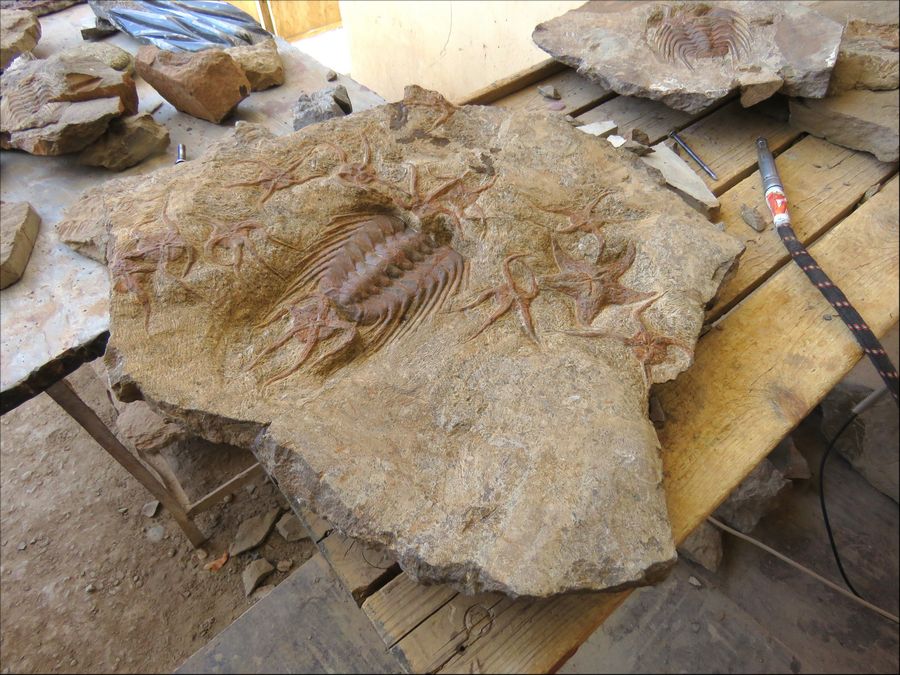
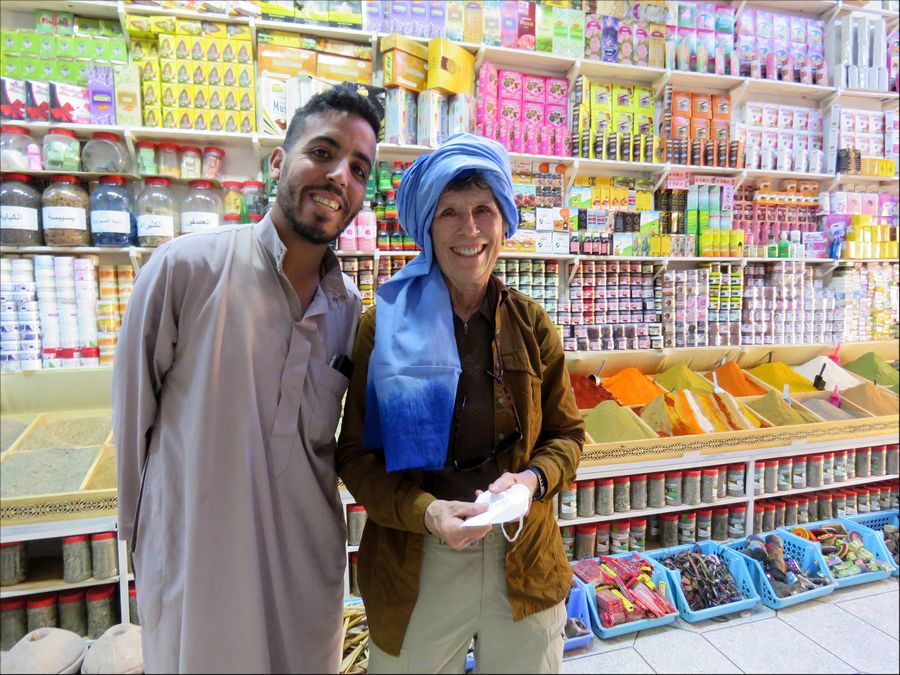
We stopped at a store where we could buy the type of headdress worn
in the Sahara Desert to protect the head from sun and cold.
I elected to wear my hiking wide brimmed hat when we were in the desert.
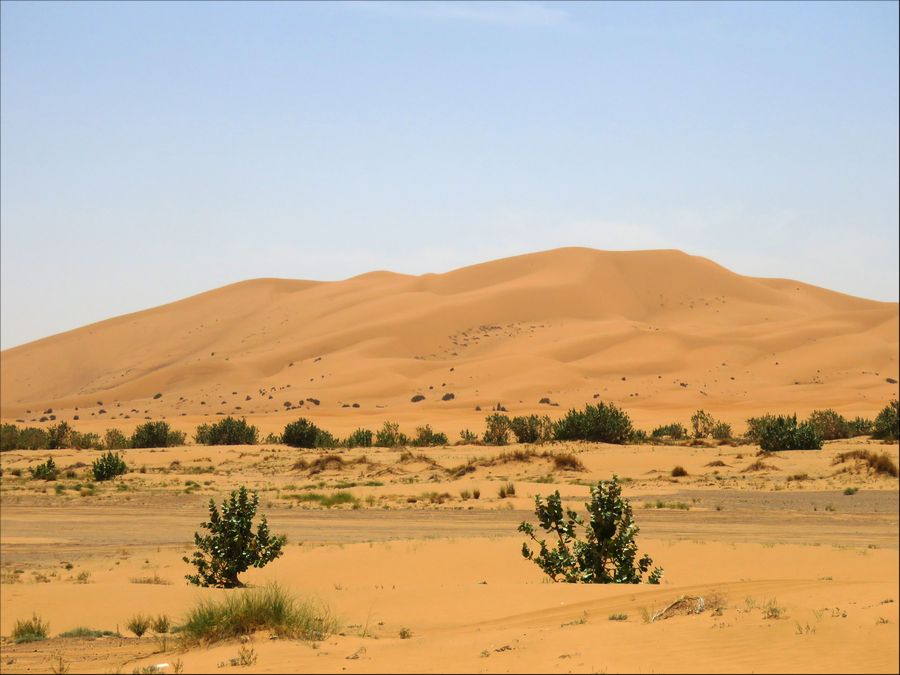
We road in 4x4 vehicles into the desert to our tent camp.
Erg Chebbi Sand
Dunes
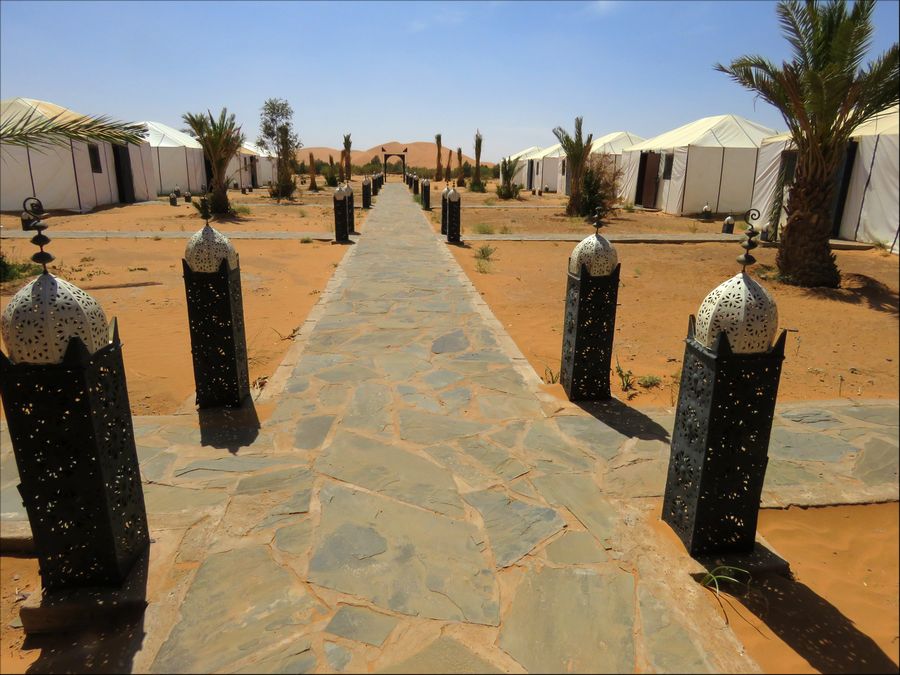
Our tent camp with lanterns to light the way at night.
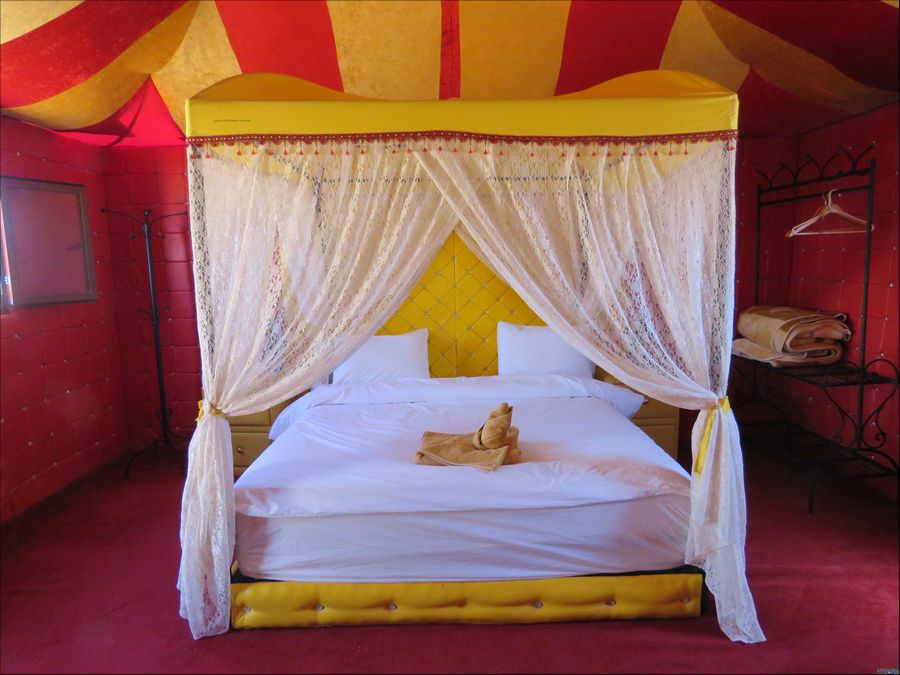
Inside my tent. It had a shower and water faucets and basin.
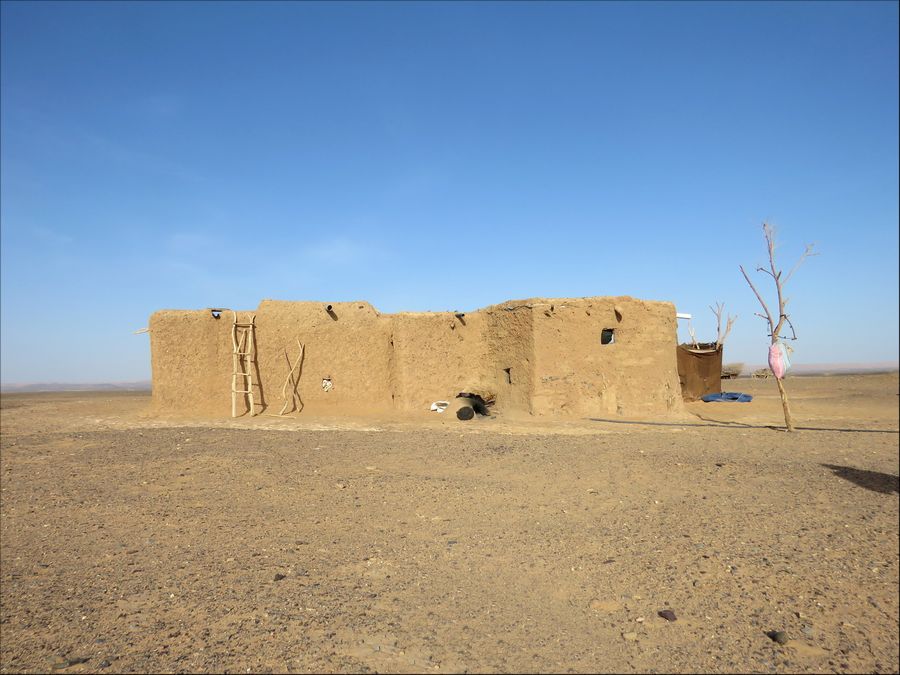
At the temporary shelter of a nomad family.
Sheep and goats require a constant search
for new pastures so nomads move from place to place.
Nomads have a souk or marketplace where they go to
get food and supplies and sell their goats.
Some live in caves.
The nomad population is dwindling
as more and more move to towns.
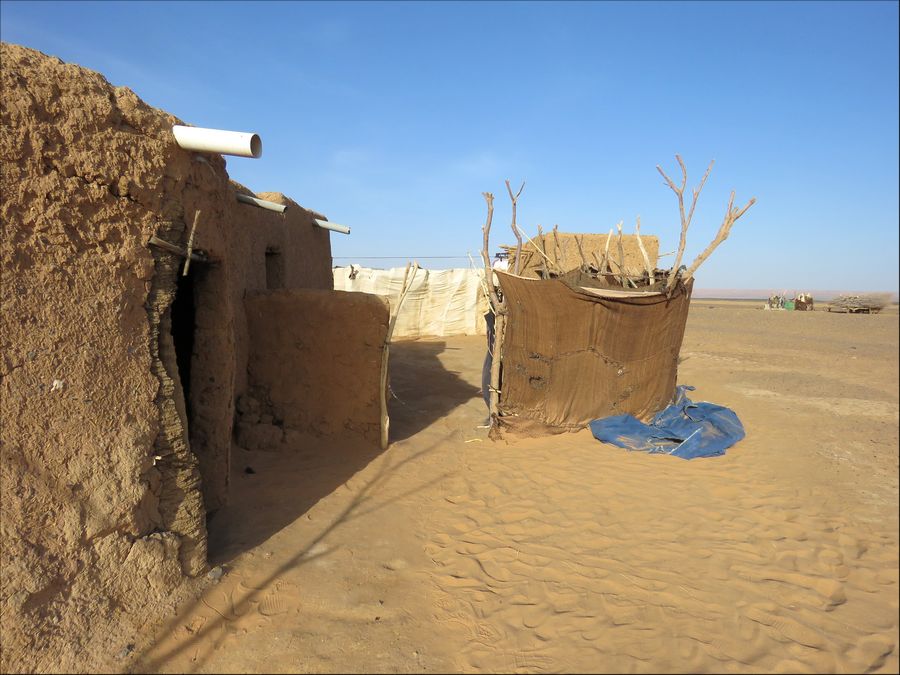
Another view of the nomad home we visited.
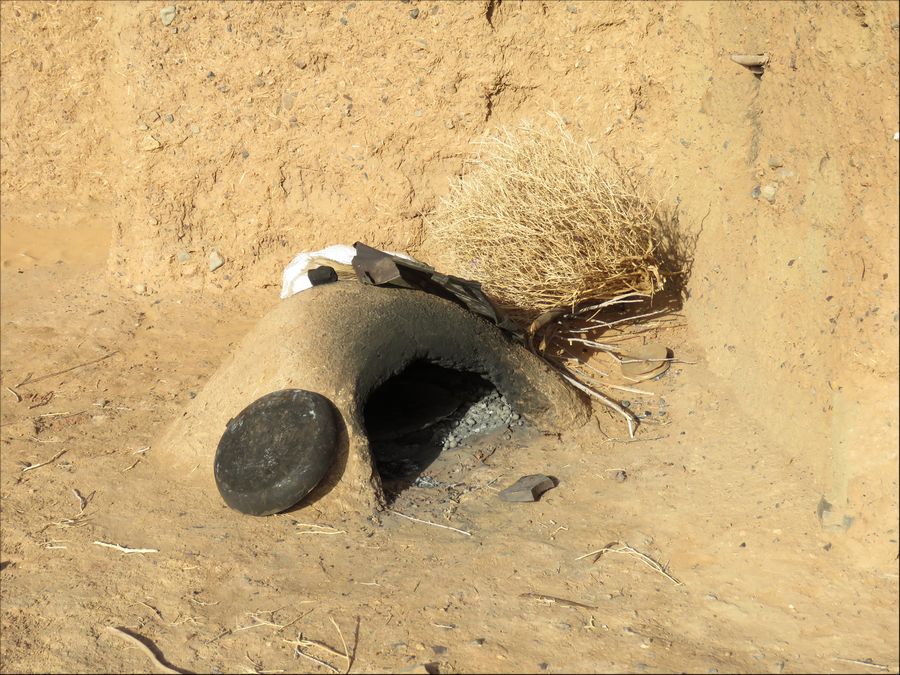
The oven for cooking
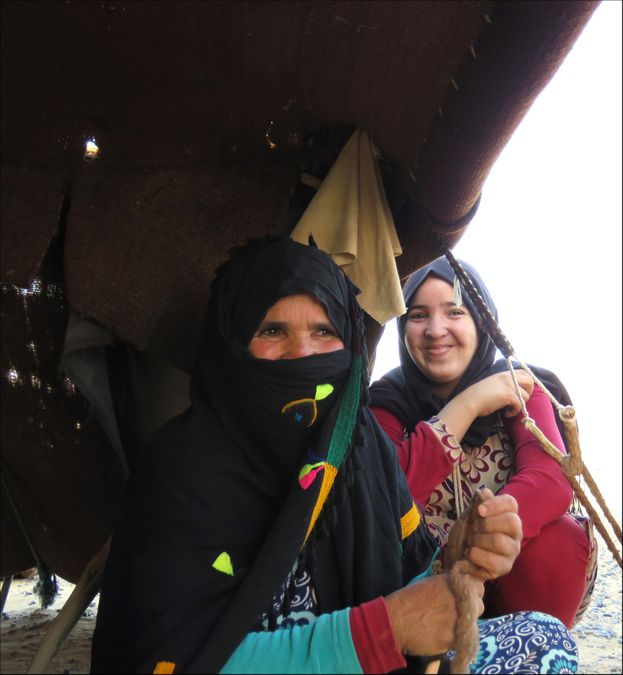
A woman and her daughter welcomed us to their current abode and talked to us about the life.
Sadly, she lost her husband to illness 2 years ago. He got sick and died within 2 weeks.
Her 17 year old daughter cannot read or
write.
The woman served us tea.
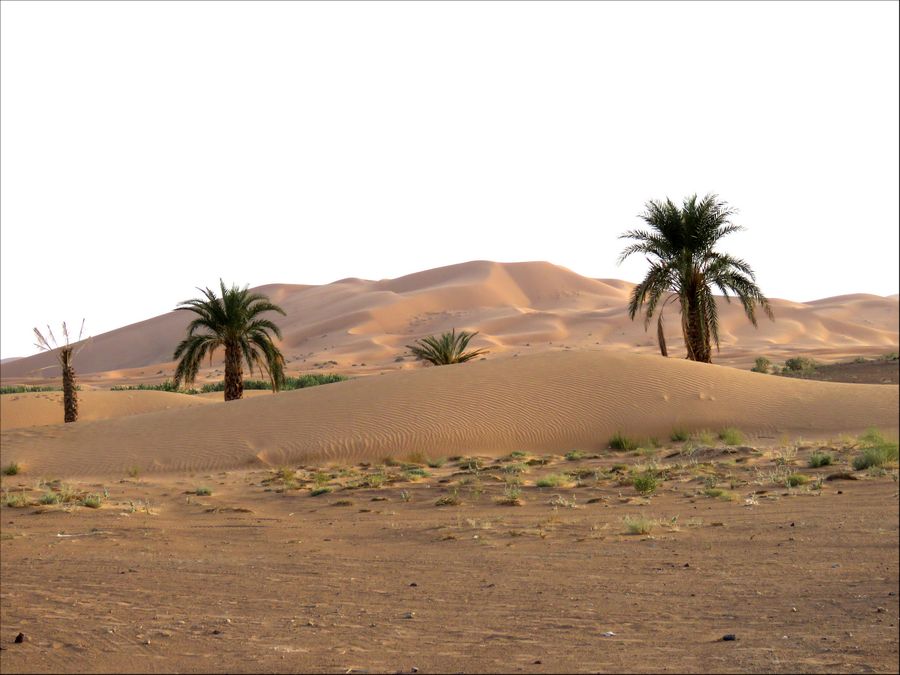
Dunes near our tent camp
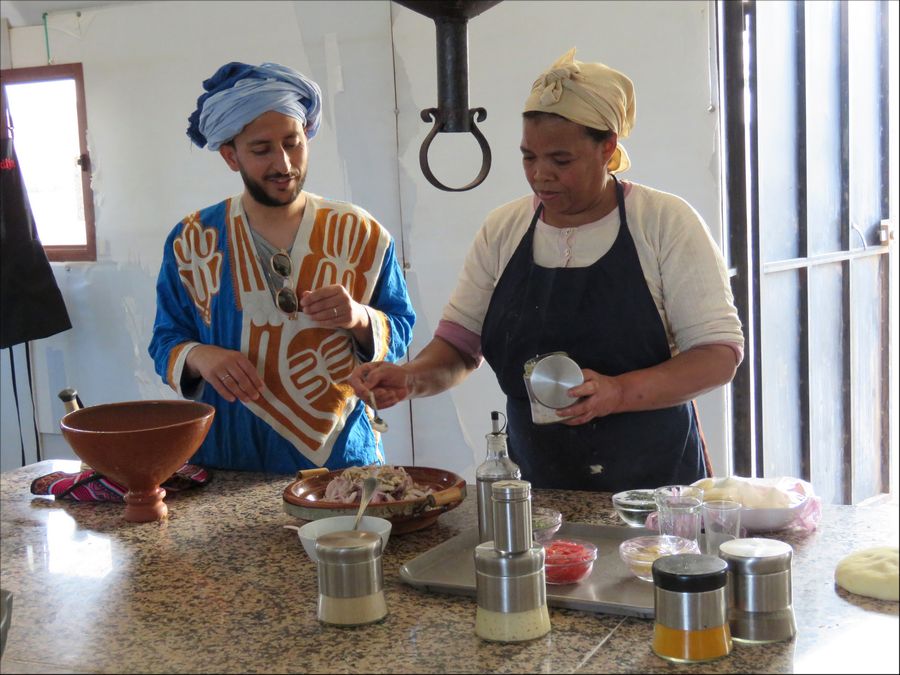
Issmail, our guide, dressed in traditional desert clothing with the cook
at the tent camp giving us a cooking demonstration. She is preparing
tagine, named after the pottery pot it is cooked in. Tagine is an important
part of Moroccan cuisine and has been for hundreds of years. It is a
stew-like dish that is slow-cooked in the traditional cookware
and is a mixture of meat, poultry, or fish, most
often including vegetables and/or fruit.
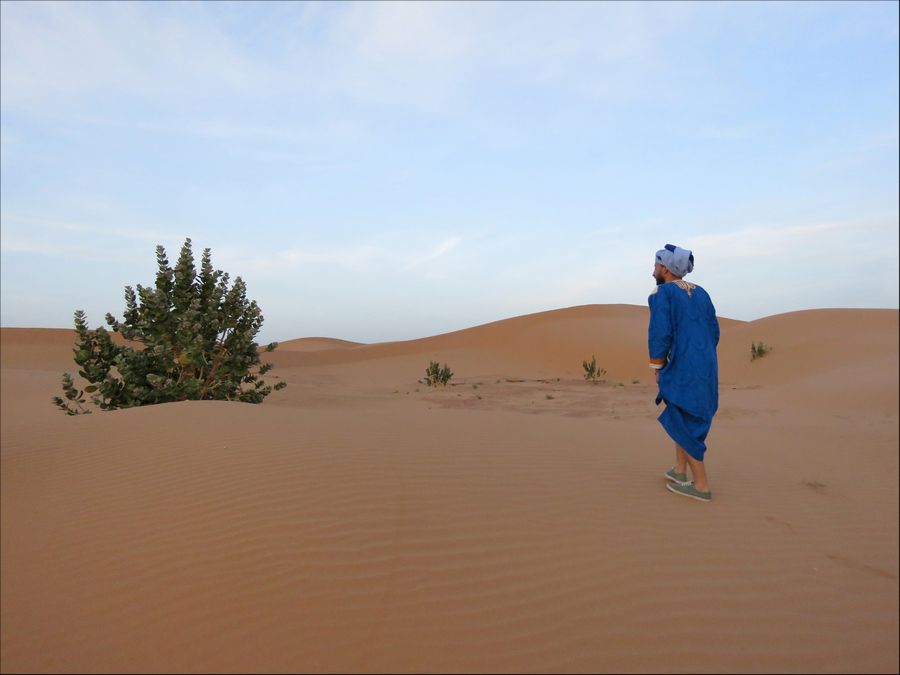
Issmail walking in the dunes near our camp where we walked after dinner
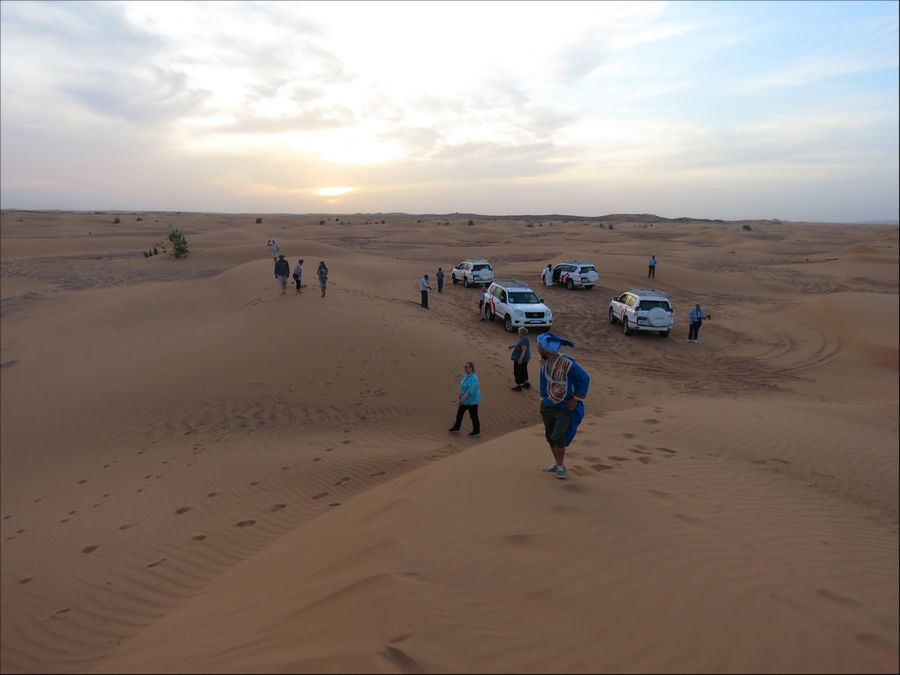
Nearing sunset
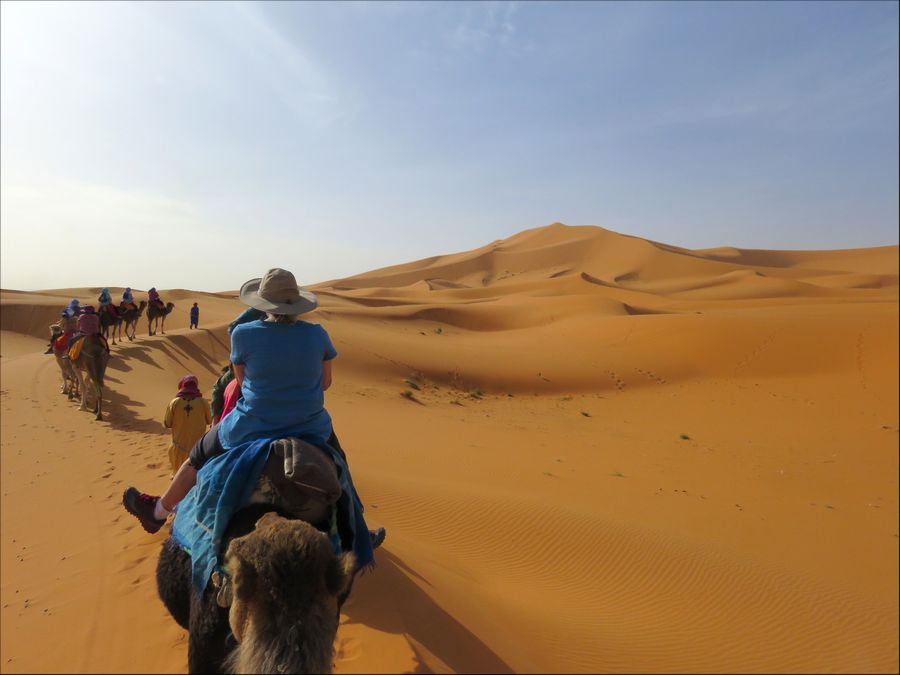
The next day we took a camel ride in the dunes.
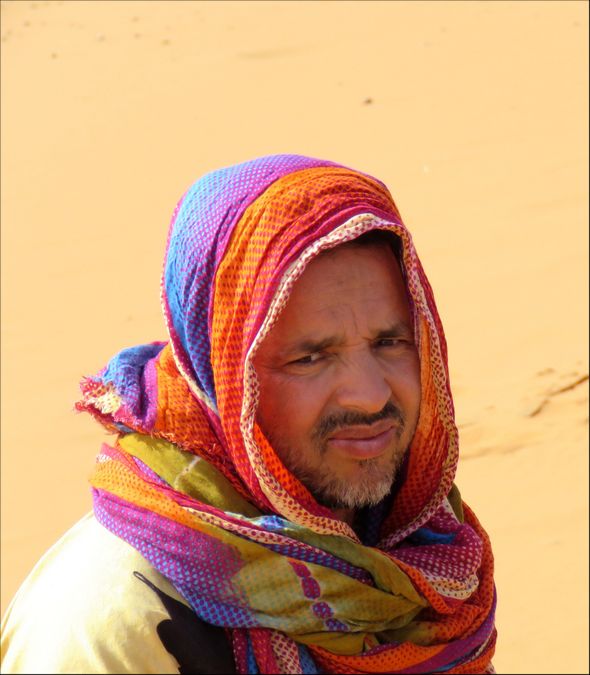
One of the men that handled the camels we were on, who walked alongside the camels.
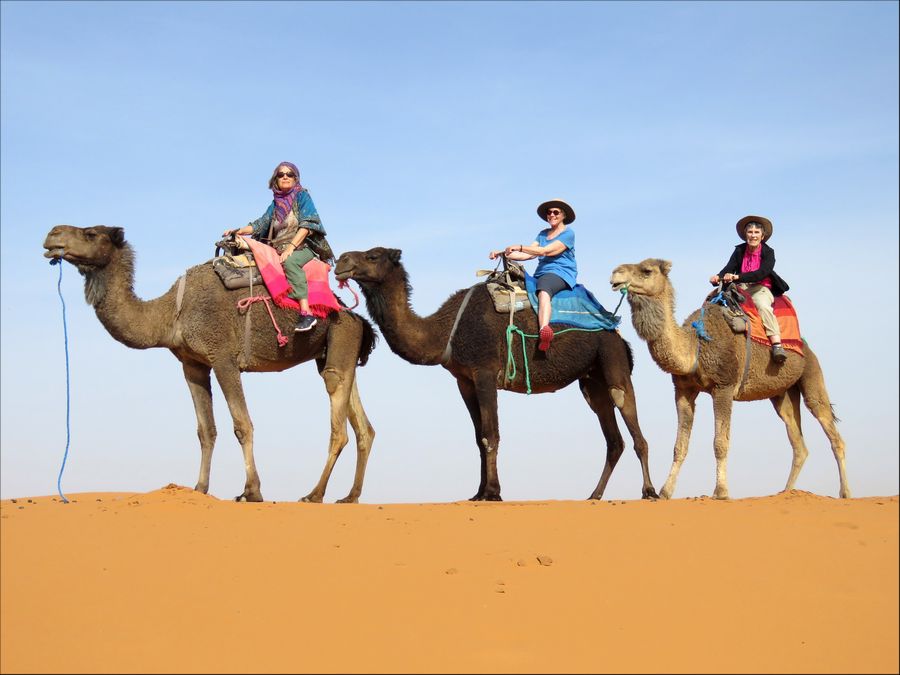
Bonnie, Pat, and me riding on our camels.
The camels were tied together to stay in line.
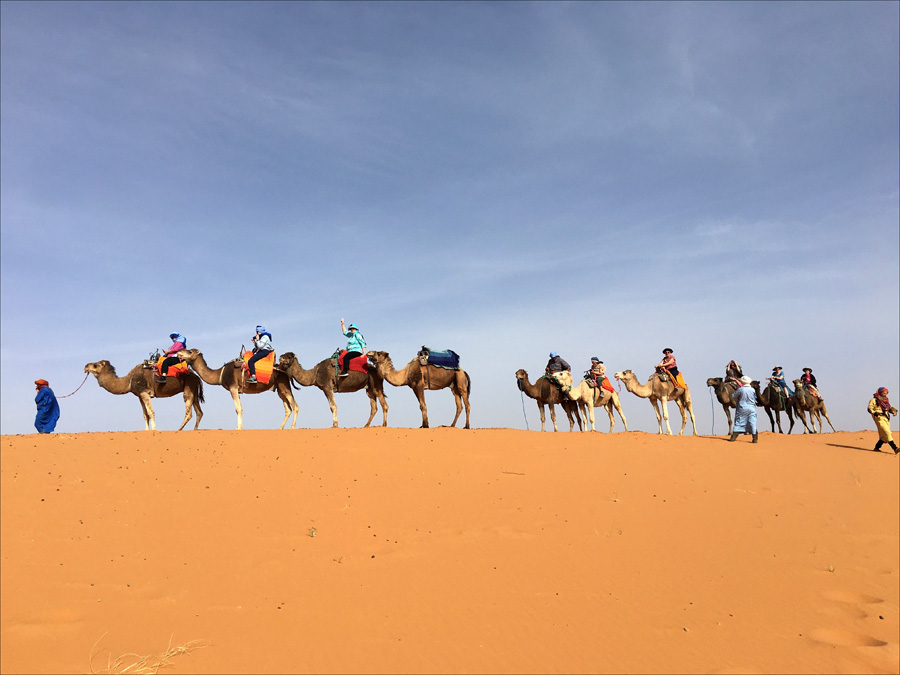
Our group of camel riders. The camel without a rider was due to someone
in our group that had to stay back at the tent camp due to traveler's diarrhea.
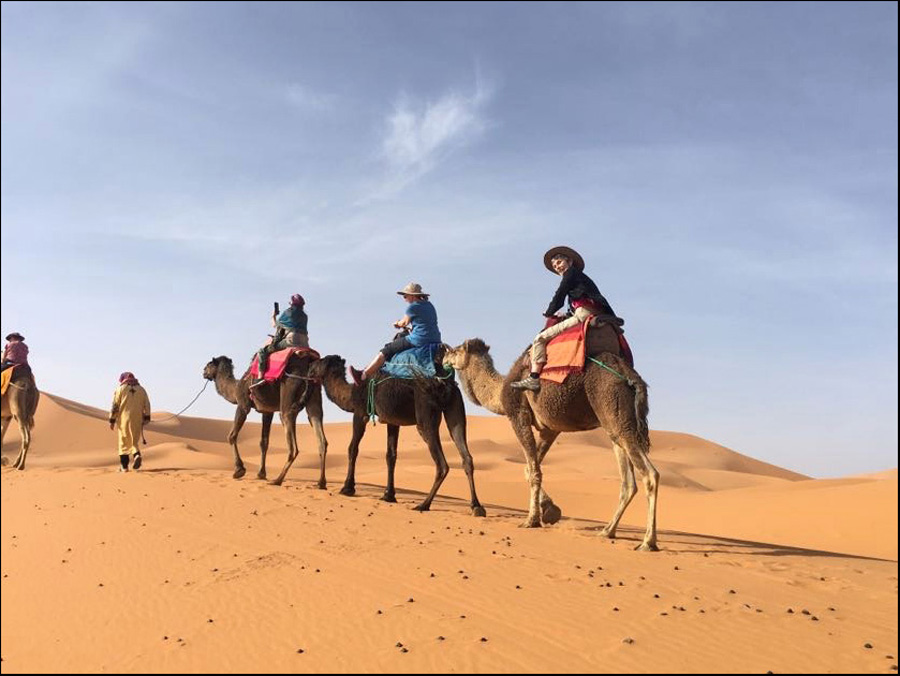
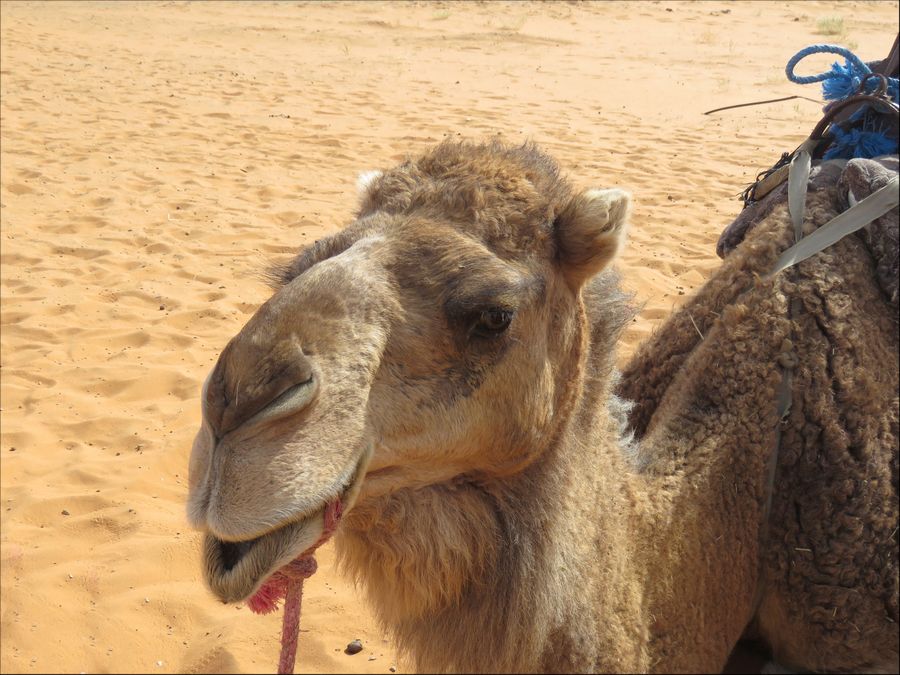
My camel sitting down at the end of our ride.
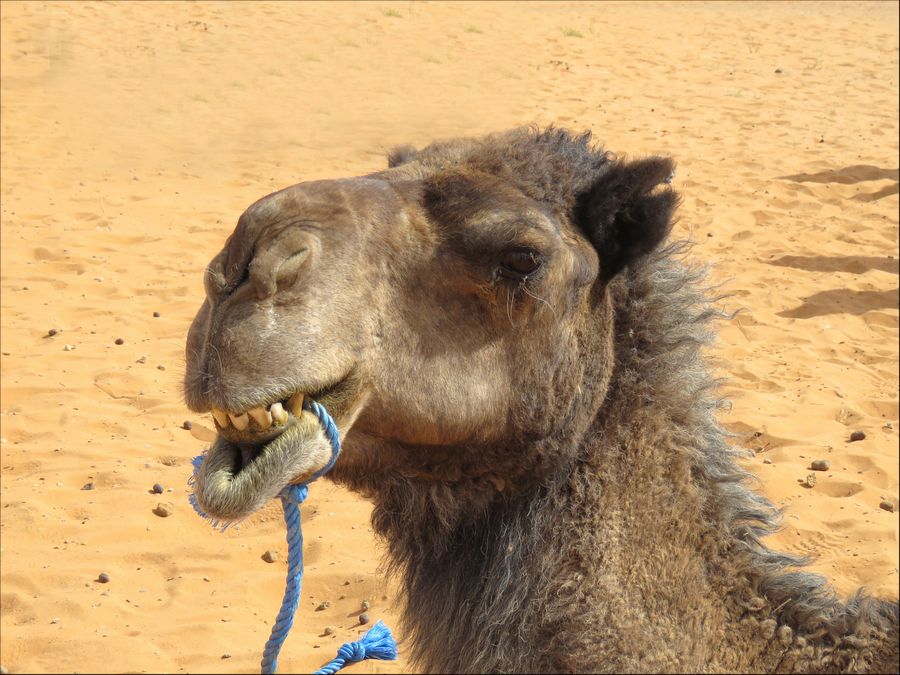
Another camel. Note the teeth.
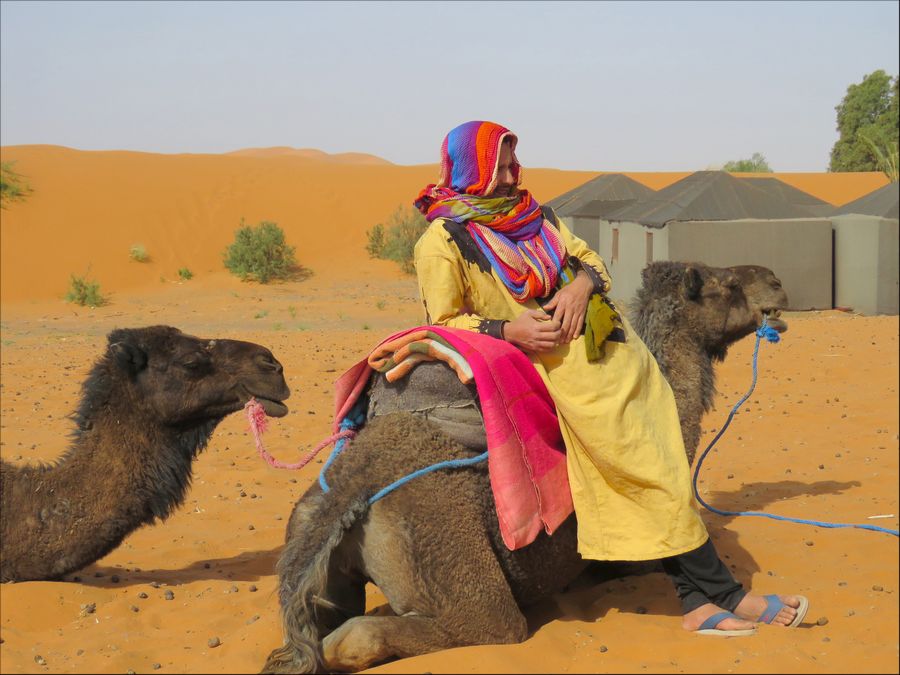
Photo taken as we were walking away after our ride
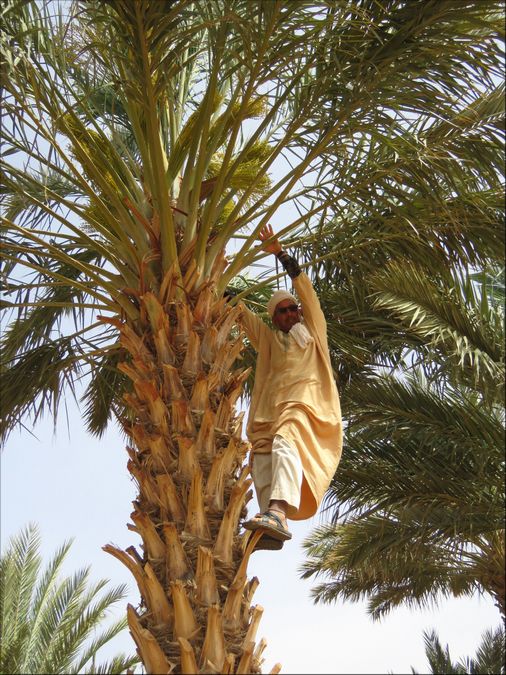
We also visited a farm in the desert to learn about local produce. The
farmer was showing us how they climb date palm trees to collect the dates.
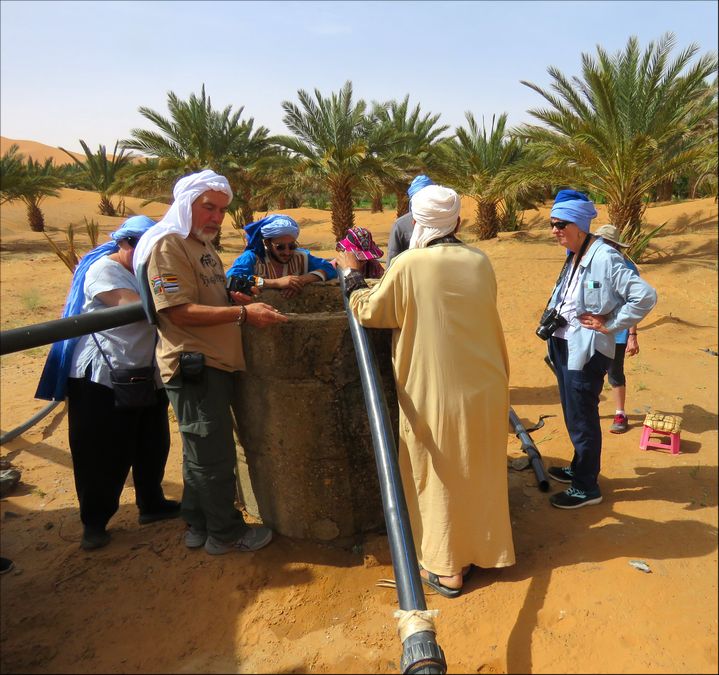
The well at the farm needed for irrigation.
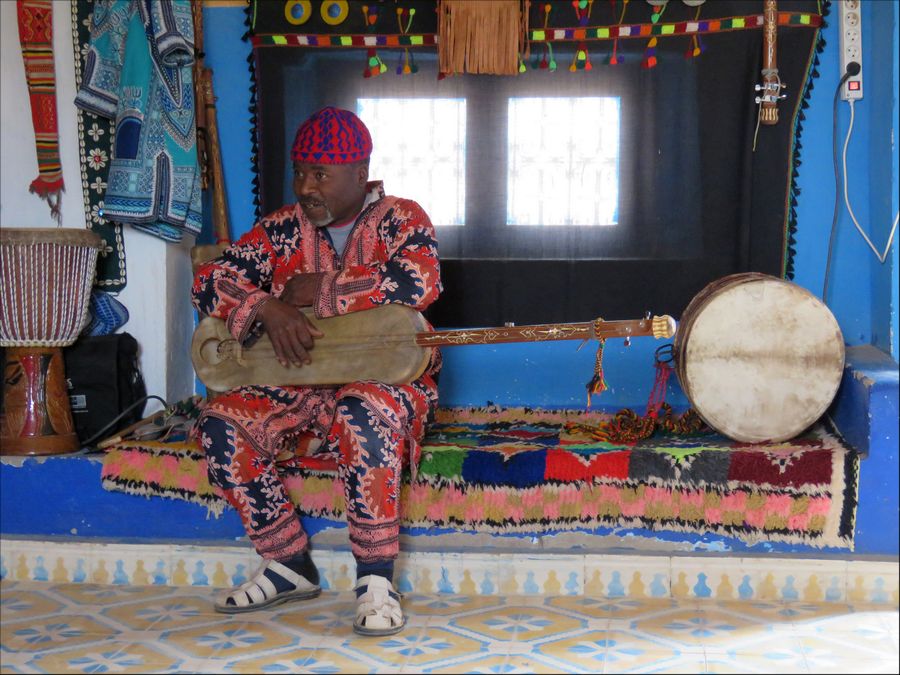
We went to Khamlia, a remote desert village.
This area is known for the ritual songs of Gnawa musicians.
Here one is demonstrating the various musical instruments they use.
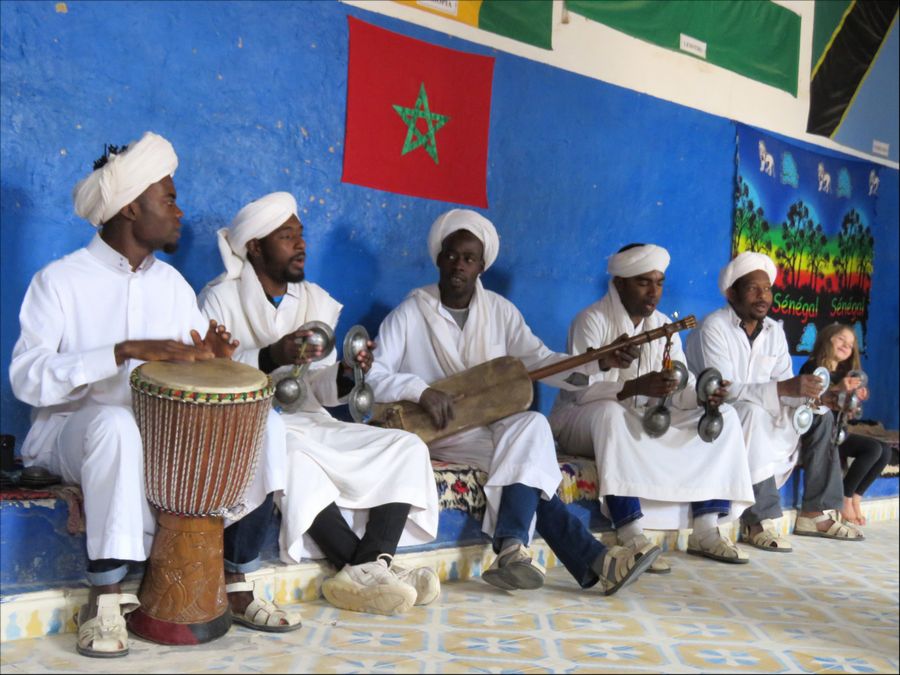
A Gnawan group entertaining us and others.
The Moroccan flag is on the wall above them.
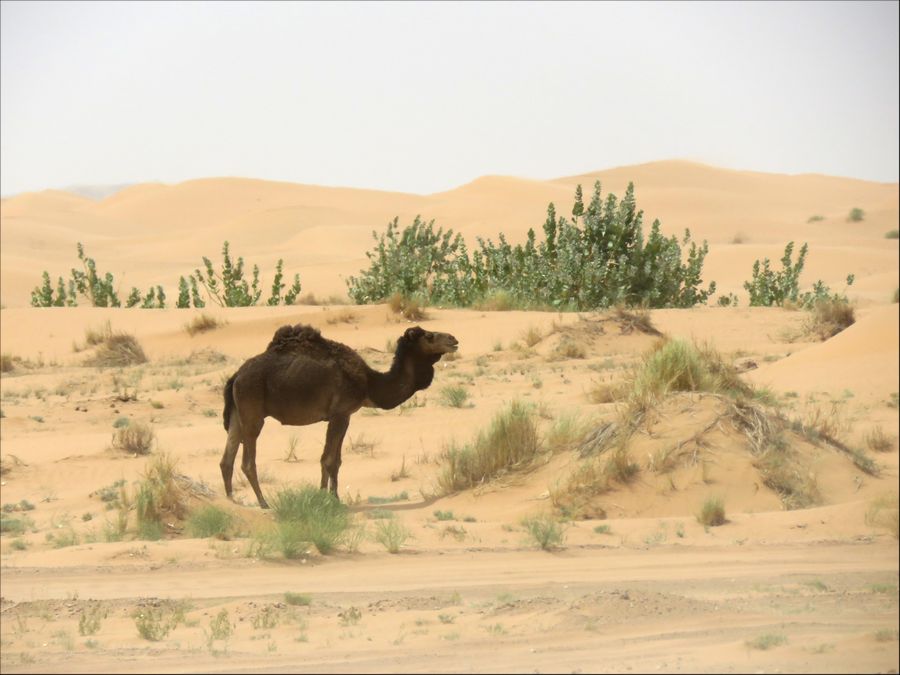
A camel grazing in the dunes
Link to Page Seven - Ouarzazate, Asfalou Village & overland to Marrakesh
Pat's Home Page